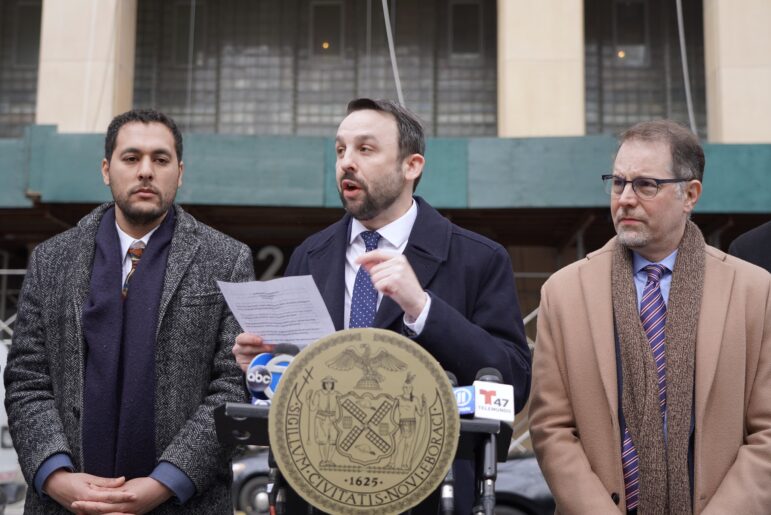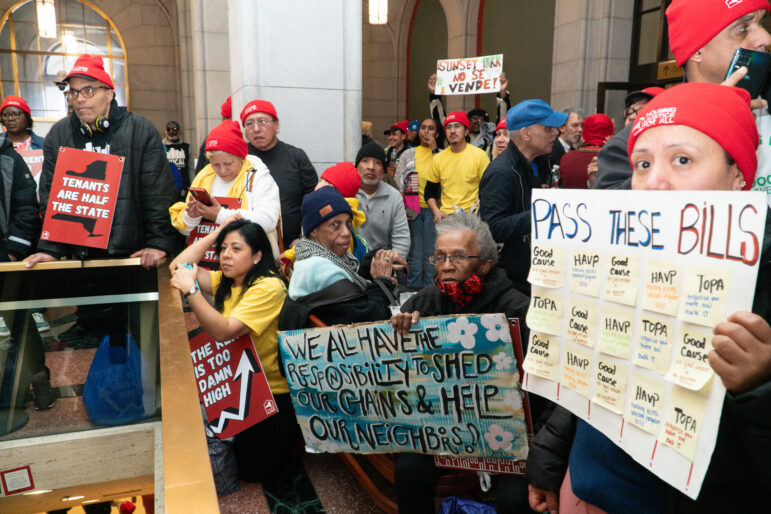The reason Gov. Eliot Spitzer kept pointing to the seat of his pants at an event Friday afternoon was that’s where he keeps his wallet—a wallet he vowed would soon contain a state driver’s license stamped with the words “not for U.S. government purposes.” He repeated this vow whenever his invited audience of reporters from the city’s ethnic and nonprofit media suggested that Spitzer’s deal last week with the federal Department of Homeland Security had created a second-tier license for undocumented immigrants. How could it be second-class, Spitzer implied, if even the governor has it?
Spitzer’s sit-down with members of the Independent Press Association at his Third Avenue office was a bid for support for his proposal to change the way New York state treats undocumented immigrant drivers. In the room were representatives from the Chinese language World Journal, the Polish daily Nowy Dziennik, and representatives of publications that deliver news in Korean, Urdu, Spanish and other languages.
Friday’s session with Spitzer and Lt. Gov. David Paterson was initially billed as “on background,” but as the assembled press nibbled on the yummy macadamia nut and macaroon cookies that had been provided, Spitzer’s press aides offered an on-the-record session in addition to the background chit-chat that, in theory, gives reporters a sense of what important people are really thinking.
Back in September, Spitzer made good on a campaign pledge and moved to allow undocumented immigrants to get the same drivers licenses as everyone else. That infuriated immigration hardliners and spurred a revolt by many of the state’s county clerks. It also created potential conflicts between New York’s proposed license and the federal Real ID law, the post-9/11 measure that requires states to issue secure identification by 2013.
After talks with Homeland Security, the Spitzer administration late last month shifted to a plan that includes three licenses: a Real ID available to U.S. citizens and legal immigrants, a specific border-crossing license for folks who frequent the Canadian frontier, and a standard drivers license that anyone—including undocumented immigrants who possess a foreign passport—can get. To distinguish the standard license from the Real ID, the license will declare that it is not valid as federal identification. In an editorial, the New York Times said Spitzer had “confronted the most intense public criticism of his political career — and caved,” and immigrant advocates chafed at the idea of a Scarlet Letter license for the undocumented.
“Most of the people are under the impression that this new policy is sort of a trap,” said Mohsin Zaheer, editor of the Sada-e Pakistan weekly, who attended the event. People fear “that those who apply for [the license] will be caught in the trap by federal authorities who are desperate to find undocumented immigrants, especially in the Muslim community,” Zaheer said in an interview Monday.
Spitzer said Friday that many people with legal status will go for the un-Real ID license, too. With 35 percent of New Yorkers holding a passport that they can use as their Real ID, he argues, many native-born Americans will opt for the driver’s license rather than the costlier and harder to obtain Real ID. That assumes that people will be willing to carry their passport whenever they fly domestically or enter a federal facility. But Spitzer and his homeland security czar Michael Balboni insist they will both get a drivers license, not the Real ID.
The question on the minds of the ethnic press—many of whose readers fear the feds’ knock on the door—wasn’t so much who’d get the new drivers license, but whether anyone in federal law enforcement would get a look at the list of people who had it. Spitzer tried to assure the room that, “There is nothing in the database that will say whether a person is documented or not.” But even if every member of the Spitzer administration gets the license rather than the Real ID, it seems fair to predict that most people who hold the license will be undocumented immigrants. A federal agency looking for such immigrants might be keen to get the list of license holders.
Spitzer said there’d be no data sharing, although he allowed that his administration would provide information that had been subpoenaed. He added that he was considering issuing an executive order prohibiting police and others from drawing an inference that a person with the new driver’s license was an illegal alien. That did not provide the reporters in the room with a rock-solid recommendation they could pass on to readers.
“I think it’s just going to create a two-tier system and people will be easily detected. People are very apprehensive. Most people I talk to aren’t going to get it, at least not at first,” Ewa Kern-Jedrychowska, a reporter for Nowy Dziennik, said Monday. “They’re going to wait and see. And even if Spitzer tries to assure us that he will get it and that most Americans will be too lazy to get the Real ID, at a certain point these licenses will expire and people will apply for the Real ID. That’s very obvious to me.”
“He told us that the DMV was not the ICE,” said Zaheer, referring to U.S. Immigrations and Customs Enforcement. “It’s up to reader to decide, are they going to believe in him or not?”
The contrast between what the governor proposed in September and what he agreed to last week might be substantial, but the administration doesn’t own up to having lost anything in the process, let alone having handled the situation badly. They argue that New York’s decision to comply with the Real ID act neutralizes any security concerns about giving IDs to undocumented immigrants and allows the state to license more drivers. They shrug that anti-immigrant commentators didn’t lash back any fiercer than expected. The governor didn’t cave in at all, according to his office.
Spitzer impressed Zaheer and Kern- Jedrychowska by inviting the community press in. Others in attendance seemed grateful too – taking plenty of pictures of Spitzer on their digital cameras as he rose to leave the briefing – even if his answers didn’t gel with New York’s immigrants’ street-level view.
Kern-Jedrychowska said many in her community never thought Spitzer’s original plan would be realized, and wondered why the governor wasn’t savvier.
“He should have known better. If the immigrants I spoke to were 100 percent sure—they were sure—that it wasn’t going to go through, then he should have known better,” she said. “I don’t think that he explained why he has changed his mind. He got a lot of people’s hopes up.”








